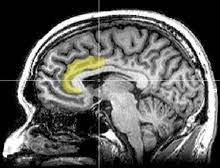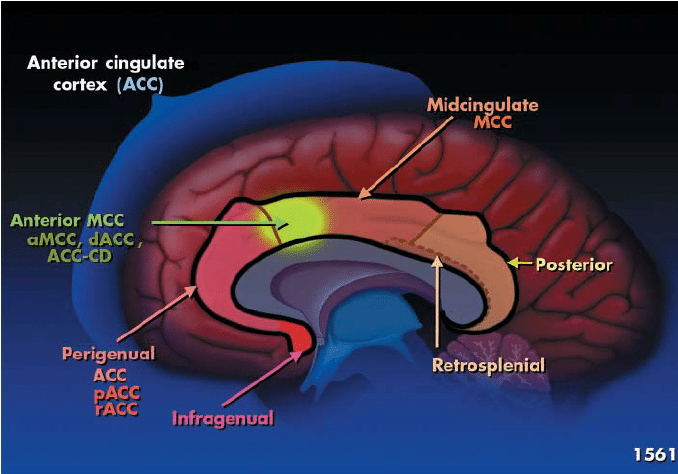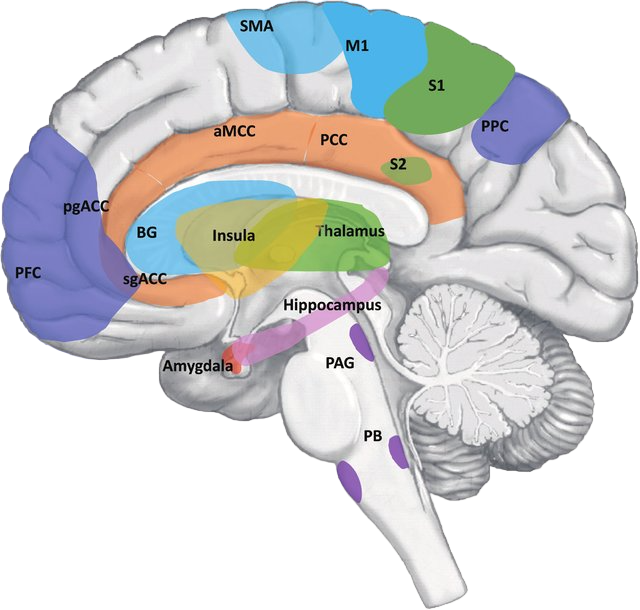aMCC: The Anterior Mid-Cingulate Cortex and Your Life
-KK 01/02/24

-KK 01/02/24

In this article, it shall be elucidated the relatively new discoveries surrounding this region of the brain, why they are interesting, and how one might think of drawing inspiration from them, and in the best case, apply it themselves.
The anterior mid-cingulate cortex (aMCC) is broken down as follows:
Anterior: Derived from Latin "anterior," meaning "before" or "in front of." In anatomical terms, it refers to the front part of the body or body structures.
Mid-Cingulate: The cingulate cortex is a part of the brain situated in the medial aspect of the cerebral cortex. "Cingulate" comes from the Latin "cingulum," meaning "girdle" or "belt," reflecting the cingulate cortex's position as a belt-like structure encircling the corpus callosum. The term "mid-cingulate" refers to the middle segment of the cingulate cortex, distinguishing it from its anterior and posterior parts.
Cortex: From the Latin "cortex," meaning "bark," referring to the outer layer of the brain. The cortex is involved in numerous high-level brain functions, including thought, memory, emotion, touch, motor control, and much more.


aMCC is a fascination region, because it is involved in the processing of a diverse set of inputs. But for the focus of this article, we shall discuss the effort-based decision making aspect of it.
Having established the functional link between the PFC (Prefrontal Cortex), it comes to no surprise the decision making takes place in the aMCC too.
However, latest studies by Harvard researchers and others have pointed towards this facet of aMCC actually being linked to "Willpower" of a person so to speak.
Linked in an eerily direct way, as the aMCC is observed to shrink and grow under exertion of "willpower" of a person, over a not-so-long period of time.
Indeed, the "xyz" studied proved this with a training regime last about half a year, where the sample population who did train saw increase in size of their aMCCs.
On the not so positive note, aMCC in people with: depression, obesity or a general idolent attitude towards life was found to be positively correlated to it being smaller in size.
But does the size matter ?
Yes it does ! The research did not merely conduct these studies for the sake of it. If the negative correlations weren't enough to convince you, the fact that a more developed aMCC is assosciated with a phenomenon called "Superaging" and overall better cognitive health should vault one over the bar of indifference. It was also found that people who lived for long tended to have a bigger aMCC on average.
This is profound, the aMCC can be seen as the will to live. Hardocore
Indeed, it was found in xyz that ...
The main takeaway is rather useful, as not only the research confirms the ability for individuals to practice willpower and develop this region of brain, but also the fact that doding harder things will become easier over this period of "self-challenging", having a catapult effect.
Here are 3 clever things you can do to develop your aMCC and do the hard things:
1) Leverage the Ultradian Rhythym : Working in blocks of 90 minutes, followed by a restorative-break of 20 mins is optimal. This utilises the natural deep-work rhythym of your body when your cognition is at its peak. The restorative-break is also strategic - something mathematicians and phycisists are well versed with - as it allows the mind to assimilate the work processed, while allowing your creative juices to work their wonder.
2) Optimise Dopamine Production : Sleep is king for this. But besides your 7.5 or 9 hours (yes, not 8. why?), the list would be too long. An underrated tactics are to go on a low carb diet, while maximising slow-release proteins and fat sources. This mitigates the dreaded afternoon crash, and retains mental acuity for longer.
More on the mental side, try to reframe your tasks/goals in a curious, playful way. Enjoying the process (and thereby linking dopamine release to that) is vastly more beneficial long term than to endure in hope for a short-lived reward.
3) Pump Iron : Perhaps the simplest, healthiest and most challenging way to grow the aMCC is to workout.